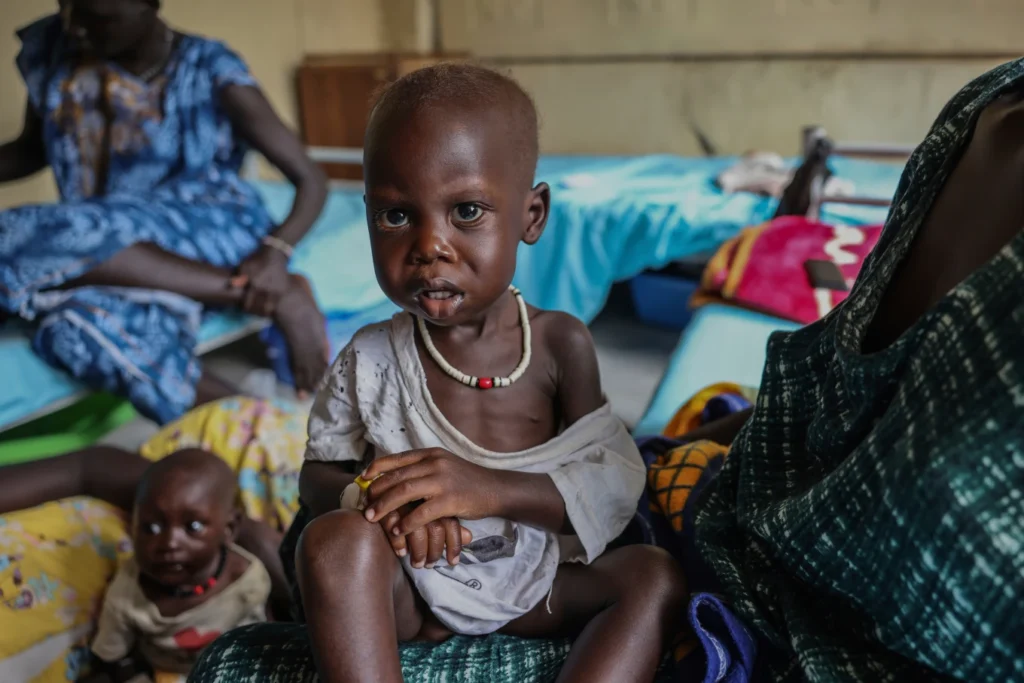The United Nations and the Government of South Sudan have sounded the alarm over worsening food insecurity in the country, warning that millions could face acute hunger if urgent action is not taken.
According to the latest Integrated Food Security Phase Classification (IPC) report released on Tuesday in Juba, about 7.56 million people, more than half of South Sudan’s population, are projected to face crisis or worse levels of food insecurity during the 2026 lean season between April and July.
The report further estimates that over two million children could suffer from acute malnutrition during the same period, while 28,000 people in parts of Luakpiny/Nasir and Fangak counties remain trapped in catastrophic (IPC Phase 5) conditions just one step away from famine.
“Particularly alarming is the situation in Luakpiny/Nasir County, where a risk of famine persists due to ongoing conflict and restricted humanitarian access,” said Vice President Hussein Abdel Bagi Akol, speaking at the launch of the report.
He said about 5.97 million people, representing 42 percent of the population, are already facing crisis or worse levels of hunger, a figure projected to rise sharply if insecurity, flooding, and economic challenges persist.
Akol identified conflict, economic instability, and climate shocks as the main drivers of food insecurity, noting that they continue to “erode resilience and productivity across our nation.”
He said the government has rolled out a Food Security Crisis Preparedness Plan aimed at improving early warning and strengthening national response to hunger and malnutrition.
Meanwhile, Anita Kiki Gbeho, the UN Deputy Special Representative and Humanitarian Coordinator, described the findings as “a sobering reminder of the daily struggles and resilience of millions of South Sudanese.”
“Hunger in South Sudan is not just a failure of food production; it is a consequence of conflict, climate change, and economic fragility,” Gbeho said.
She warned that the spillover from the war in Sudan has worsened the crisis, displacing families and stretching humanitarian resources. However, she noted that in relatively stable parts of the Equatorias and Greater Bahr el Ghazal, improved security has enabled farmers to plant and harvest more food.
“Peace is the foundation upon which food security, resilience, and development are built,” Gbeho added, urging greater humanitarian access to areas such as Nasir County, where conflict and floods continue to block aid deliveries.
For his part, Adham Affendi, the World Food Programme (WFP) Deputy Country Director for Operations in South Sudan, said that while there have been modest improvements in food security, South Sudan remains one of the world’s most severe hunger crises.
He noted that 53 percent of the population is projected to face crisis or worse levels of hunger during the 2026 lean season, making South Sudan the second-highest globally in food insecurity prevalence.
“We welcome the relatively good news that Malakal, Pibor, and Olang counties are no longer projected to face catastrophic hunger in 2026,” Affendi said. “This shows that through collective efforts, we can avert famine.”
However, he warned that these gains are fragile and could be reversed if humanitarian support and access are not sustained.
Affendi underscored that continued challenges to humanitarian access are diverting critical resources and time that should be reaching those most in need. He pointed to new areas of concern, including Panjam and Canal/Pigi counties, where malnutrition rates remain high.
“The data clearly shows the link between conflict, insecurity, and hunger,” he said. “Where peace holds, communities recover. Peace enables progress towards eradicating hunger.”
He echoed the government’s message that sustaining peace is key to boosting productivity, strengthening resilience, and restoring hope for South Sudanese families.
Ismail Kamil, UNICEF’s Deputy Country Representative for Operations in South Sudan, said that millions of children and mothers across the country face alarming levels of malnutrition and need urgent assistance.
He said the latest IPC analysis shows that between July 2025 and June 2026, about 2.1 million children under five are acutely malnourished, including 670,000 suffering from severe malnutrition, while 1.1 million pregnant and breastfeeding women also require treatment.
“Seven in ten of these cases are concentrated in Jonglei, Upper Nile, Unity, and Northern Bahr el Ghazal states, areas that have endured insecurity and displacement in recent months,” Kamil said.
He warned that malnutrition is expected to worsen during the April–June 2026 lean season, as continued conflict, flooding, disease outbreaks, and high food prices erode families’ ability to cope.
The UNICEF official called for collective and sustained action to preserve humanitarian access and strengthen early detection and treatment of malnutrition.
“Our collective presence and resources are urgently needed. Young lives are at stake even today,” he said, urging government, UN agencies, donors, and partners to protect the first 1,000 days of life through multi-sectoral interventions.




